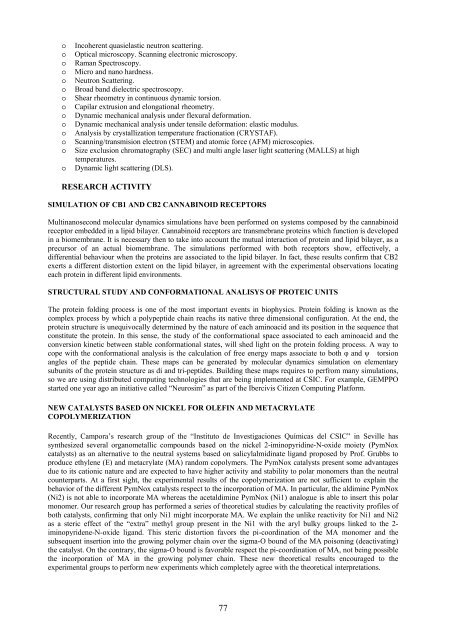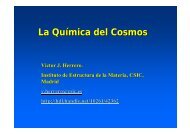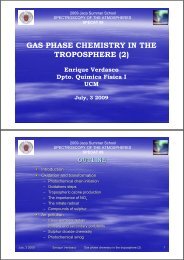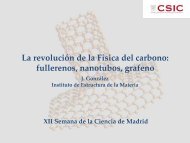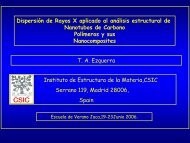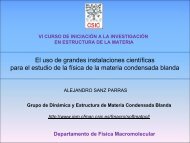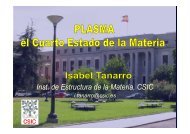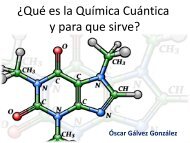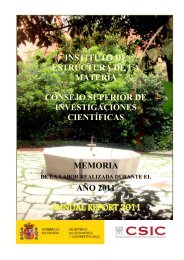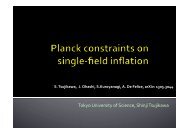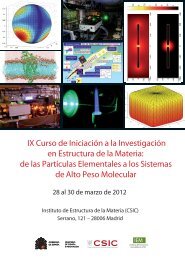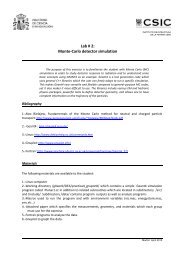memoria de 2009 - Instituto de Estructura de la Materia - Consejo ...
memoria de 2009 - Instituto de Estructura de la Materia - Consejo ...
memoria de 2009 - Instituto de Estructura de la Materia - Consejo ...
Create successful ePaper yourself
Turn your PDF publications into a flip-book with our unique Google optimized e-Paper software.
o<br />
o<br />
o<br />
o<br />
o<br />
o<br />
o<br />
o<br />
o<br />
o<br />
o<br />
o<br />
o<br />
o<br />
Incoherent quasie<strong>la</strong>stic neutron scattering.<br />
Optical microscopy. Scanning electronic microscopy.<br />
Raman Spectroscopy.<br />
Micro and nano hardness.<br />
Neutron Scattering.<br />
Broad band dielectric spectroscopy.<br />
Shear rheometry in continuous dynamic torsion.<br />
Capi<strong>la</strong>r extrusion and elongational rheometry.<br />
Dynamic mechanical analysis un<strong>de</strong>r flexural <strong>de</strong>formation.<br />
Dynamic mechanical analysis un<strong>de</strong>r tensile <strong>de</strong>formation: e<strong>la</strong>stic modulus.<br />
Analysis by crystallization temperature fractionation (CRYSTAF).<br />
Scanning/transmision electron (STEM) and atomic force (AFM) microscopies.<br />
Size exclusion chromatography (SEC) and multi angle <strong>la</strong>ser light scattering (MALLS) at high<br />
temperatures.<br />
Dynamic light scattering (DLS).<br />
RESEARCH ACTIVITY<br />
SIMULATION OF CB1 AND CB2 CANNABINOID RECEPTORS<br />
Multinanosecond molecu<strong>la</strong>r dynamics simu<strong>la</strong>tions have been performed on systems composed by the cannabinoid<br />
receptor embed<strong>de</strong>d in a lipid bi<strong>la</strong>yer. Cannabinoid receptors are transmebrane proteins which function is <strong>de</strong>veloped<br />
in a biomembrane. It is necessary then to take into account the mutual interaction of protein and lipid bi<strong>la</strong>yer, as a<br />
precursor of an actual biomembrane. The simu<strong>la</strong>tions performed with both receptors show, effectively, a<br />
differential behaviour when the proteins are associated to the lipid bi<strong>la</strong>yer. In fact, these results confirm that CB2<br />
exerts a different distortion extent on the lipid bi<strong>la</strong>yer, in agreement with the experimental observations locating<br />
each protein in different lipid environments.<br />
STRUCTURAL STUDY AND CONFORMATIONAL ANALISYS OF PROTEIC UNITS<br />
The protein folding process is one of the most important events in biophysics. Protein folding is known as the<br />
complex process by which a polypepti<strong>de</strong> chain reachs its native three dimensional configuration. At the end, the<br />
protein structure is unequivocally <strong>de</strong>termined by the nature of each aminoacid and its position in the sequence that<br />
constitute the protein. In this sense, the study of the conformational space associated to each aminoacid and the<br />
conversion kinetic between stable conformational states, will shed light on the protein folding process. A way to<br />
cope with the conformational analysis is the calcu<strong>la</strong>tion of free energy maps associate to both φ and ψ torsion<br />
angles of the pepti<strong>de</strong> chain. These maps can be generated by molecu<strong>la</strong>r dynamics simu<strong>la</strong>tion on elementary<br />
subunits of the protein structure as di and tri-pepti<strong>de</strong>s. Building these maps requires to perfrom many simu<strong>la</strong>tions,<br />
so we are using distributed computing technologies that are being implemented at CSIC. For example, GEMPPO<br />
started one year ago an initiative called “Neurosim” as part of the Ibercivis Citizen Computing P<strong>la</strong>tform.<br />
NEW CATALYSTS BASED ON NICKEL FOR OLEFIN AND METACRYLATE<br />
COPOLYMERIZATION<br />
Recently, Campora’s research group of the “<strong>Instituto</strong> <strong>de</strong> Investigaciones Químicas <strong>de</strong>l CSIC” in Seville has<br />
synthesized several organometallic compounds based on the nickel 2-iminopyridine-N-oxi<strong>de</strong> moiety (PymNox<br />
catalysts) as an alternative to the neutral systems based on salicy<strong>la</strong>lmidinate ligand proposed by Prof. Grubbs to<br />
produce ethylene (E) and metacry<strong>la</strong>te (MA) random copolymers. The PymNox catalysts present some advantages<br />
due to its cationic nature and are expected to have higher activity and stability to po<strong>la</strong>r monomers than the neutral<br />
counterparts. At a first sight, the experimental results of the copolymerization are not sufficient to exp<strong>la</strong>in the<br />
behavior of the different PymNox catalysts respect to the incorporation of MA. In particu<strong>la</strong>r, the aldimine PymNox<br />
(Ni2) is not able to incorporate MA whereas the acetaldimine PymNox (Ni1) analogue is able to insert this po<strong>la</strong>r<br />
monomer. Our research group has performed a series of theoretical studies by calcu<strong>la</strong>ting the reactivity profiles of<br />
both catalysts, confirming that only Ni1 might incorporate MA. We exp<strong>la</strong>in the unlike reactivity for Ni1 and Ni2<br />
as a steric effect of the “extra” methyl group present in the Ni1 with the aryl bulky groups linked to the 2-<br />
iminopyri<strong>de</strong>ne-N-oxi<strong>de</strong> ligand. This steric distortion favors the pi-coordination of the MA monomer and the<br />
subsequent insertion into the growing polymer chain over the sigma-O bound of the MA poisoning (<strong>de</strong>activating)<br />
the catalyst. On the contrary, the sigma-O bound is favorable respect the pi-coordination of MA, not being possible<br />
the incorporation of MA in the growing polymer chain. These new theoretical results encouraged to the<br />
experimental groups to perform new experiments which completely agree with the theoretical interpretations.<br />
77


